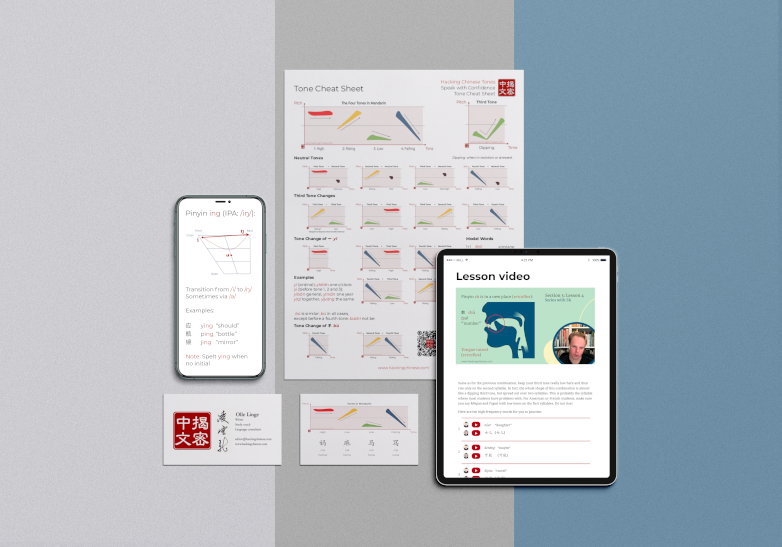 Using the right resources is important when learning anything, but it’s essential when learning Mandarin pronunciation. In this article, I share my favourite resources, most of which are completely free!
Using the right resources is important when learning anything, but it’s essential when learning Mandarin pronunciation. In this article, I share my favourite resources, most of which are completely free!
Tune in to the Hacking Chinese Podcast to listen to the related episode (#197):
Available on Apple Podcasts, Google Podcasts, Overcast, Spotify, YouTube and many other platforms!
The best resources for learning Mandarin pronunciation
I have been interested in learning, teaching and researching Mandarin pronunciation for a long time. Below, I present the best resources I have found, with an emphasis on free resources. While it’s true that some of the best resources aren’t free, it’s also true that many great resources are.
To make the recommendations more navigable, I have sorted them into four categories; feel free to skip those you don’t think you need. If you have any other resources you think ought to be on this list or Hacking Chinese Resources, please leave a comment or contact me. There are already quite a few extra resources mentioned in the comments section!
- Mandarin sound references
- Chinese pronunciation explained
- Advice on learning pronunciation
- Useful software and applications
Hacking Chinese Pronunciation: Speaking with Confidence
Before recommending free resources for learning pronunciation, I’ll shamelessly promote my pronunciation video course: Hacking Chinese Pronunciation: Speaking with Confidence. It covers everything you need to know to speak clearly and with confidence! It’s a comprehensive guide that includes almost everything I mention in this article but in one carefully structured course. It isn’t free, though, but I’ll mention it here since courses like this are what keep this website alive and I know that some of you will be interested.
1. Basic sound references for learning Mandarin pronunciation
When you start learning Chinese, it’s essential that you mimic proper model audio. It’s also important to look up how to pronounce syllables you’re not sure of; never guess or base your pronunciation on how words in English are pronounced. Several freely available resources include all syllables read with all tones. I have included more than one here because as I have explained, listening to more than one voice is helpful.
- Chinese Pronunciation Wiki Pinyin Chart – The best Pinyin chart I know. Features include audio with tones (either one specific or all four), notation using Pinyin, IPA (the International Phonetic Alphabet) or Zhuyin, as well as a full-screen mode.
- Yabla Pinyin Chart With Audio – Another web-based Pinyin chart with audio for all syllables with all tones. Note that this one includes possible combinations that don’t exist as real words.
- Pinyin audio and video on YouTube – This clip introduces all the initials and finals in Pinyin (using the first tone). It adds value to the rest of the resources here because the camera is pointed to the speaker’s mouth, showing clearly how the lips move.
- ChinesePod Introduction to Pinyin – This app is available for free on the web Android and iOS and contains the full Pinyin chart with audio. There are also articulation images and sounds explained, although this is not always correct (for example, there is no “nasal U” in Mandarin, and the retroflex sounds are not pronounced as the images show).
- YouGlish – This tool is built on a simple but powerful idea: Type or paste a word and it will search for this word on YouTube, allowing you to listen to the snippet where it’s said. You can quickly jump to the next clip, making it an awesome tool to figure out how most people pronounce most words in real life.
Please note that focusing too much on Pinyin (a transcription system) over the real sounds and tones of the language can be bad for you. Pinyin is a great tool, but only if you learn the system correctly and don’t take shortcuts. If you do, you’re very likely to get caught in one of the many traps and pitfalls!
A guide to Pinyin traps and pitfalls: Learning Mandarin pronunciation
2. Mandarin sounds and tones explained
Learning basic theory is important when learning the sounds and tones of Mandarin. As infants, we only need to immerse in the language, but for adults, simply listening to and engaging with the language is rarely enough to master pronunciation. Please note that while some theory can help, most of our practice should still be with the spoken language itself!
- The Hacking Chinese guide to Mandarin tones – In this guide, I explain everything you need to know about tones as a beginner. In the associated podcast episodes, I also give examples which can be hard to convey in writing, even though there are audio references in the article too. All beginners should start here!
- Learning the third tone in Chinese – I have spent a fair amount of time researching the third tone in Mandarin. In this article, I share some of the results and discuss what they mean for you as a learner.
- Zein on Mandarin Chinese Phonetics – This introduction is suitable for most beginners. As mentioned above, I don’t like talking too much about equivalent sounds in English, but he does a fair job most of the time.
- Chinese Pronunciation on Sinosplice – This is a short but good introduction to some of the sounds that are unique to Mandarin (at least from the perspective of a native English speaker). It’s not very exhaustive, but still a good introduction.
- Standard Chinese Phonology on Wikipedia – This article is good and is the next step if you want to go beyond just describing how sounds are pronounced. There are also lots of useful references here.
- A guide to Pinyin traps and pitfalls: Learning Mandarin pronunciation – My article is about various common problems students have with Pinyin. These problems mostly exist because people read Pinyin as if it were a phonetic alphabet instead of a transcription system.
- The Sounds of Chinese (Lin Yen-Hwei) – This book is the best introduction to Mandarin phonetics that I know of. While the book is not freely available online, you might be able to get hold of it through a library or other institution.
- The Phonology of Standard Chinese (Duan-mu San) – This book is a great resource for anyone who thinks they know a little bit about phonetics and phonology and want a more thorough discussion.
How learning some basic theory can improve your Mandarin pronunciation
3. Advice on learning and improving Mandarin pronunciation
- Improving your Chinese pronunciation by mimicking native speakers – By far the best way to learn to pronounce Mandarin clearly and naturally is to mimic native speakers. In this article, I explain why. There’s also an accompanying video where I show exactly how to mimic.
- How to learn Chinese pronunciation as a beginner – Just started learning Mandarin? Then this article is for you. It goes through some fundamental principles for how to practise pronunciation for long-term success.
- Improving pronunciation beyond the basics – No longer a beginner? Then this article is for you. It focuses on how to improve when you can already communicate, why pronunciation matters beyond just being roughly right, and how to polish your accent and avoid fossilisation.
- A smart method to discover problems with Mandarin sounds and tones – I have referred to this article already, but I want to mention it again. It introduces a really neat way of testing pronunciation without having a teacher. Everybody should try this at least once.
- Get to know your Chinese voice to level up your speaking ability – This is a closer look at how you can use recording as a tool to improve pronunciation. Most of what I cover here has appeared in different parts of this guide.
- John Pasden’s tips on Chinese pronunciation – I have referred to specific parts of this site earlier, but this is the main page for everything about pronunciation. John has many good things to say about pronunciation, listen to him!
Improving your Chinese pronunciation by mimicking native speakers
4. Useful software and applications
Here, I have collected some useful apps for improving your pronunciation. I should say that I have received several recommendations for tools that purport to verify your pronunciation through text-to-speech, but I don’t think that any of them work very well. For more about this, see Using speech recognition to improve Chinese pronunciation):
- Tone training course (WordSwing) – This is a course I built together with Kevin Bullaughey for a research project focusing on learning to hear (not say) the tones. Learning to hear the tones is essential, so if you struggle to identify basic tones, this resource is great!
- Audacity – This program is excellent for mimicking purposes, but also for careful listening in general. It’s easy to use and available for free on most platforms. It’s a powerful audio editing and playback software that allows you to view and edit audio, as well as slow down, speed up, mute channels and much more. The link goes to my article about using Audacity and I introduce more tricks there.
- Praat – This is one of the most widely used programs when it comes to scientific analysis of pronunciation. The program is not made for students specifically, but you can get pretty far just by using the material available on the website. Praat is free and works on most platforms. One of the most important features for students is to be able to see pitch contours and compare these to those of native speakers.
- Pleco – This is my favourite Chinese dictionary (available for both Android and iOS), but that’s not why I mention it here. If you’re okay with investing a few bucks (one-time purchase), you can get native-speaker audio for almost all words. This is not synthesised sound, they record each word manually!
- AllSet Learning Pinyin – This resource is only available for iPhone and iPad but is free to download. It contains audio for all syllables in Mandarin (including tones) plus some other useful features.
You can learn to pronounce Mandarin, good luck!
 Having the right resources is just part of successful language learning. Just as you won’t get strong simply by reading how to do push-ups or purchase gym equipment, you won’t get good at pronouncing Chinese unless you practice.
Having the right resources is just part of successful language learning. Just as you won’t get strong simply by reading how to do push-ups or purchase gym equipment, you won’t get good at pronouncing Chinese unless you practice.
Still, having the right resources will make learning to pronounce the sounds and tones of Mandarin considerably easier, and if you follow the advice linked to in this article and invest some time and effort, I’m sure you will succeed!
For more structured and personalised guidance, including the option to receive personal feedback from me, please check out Hacking Chinese Pronunciation: Speaking with Confidence.
Editor’s note: This article, originally published in 2013, was rewritten from scratch and massively updated in May 2024.

Tips and tricks for how to learn Chinese directly in your inbox
I've been learning and teaching Chinese for more than a decade. My goal is to help you find a way of learning that works for you. Sign up to my newsletter for a 7-day crash course in how to learn, as well as weekly ideas for how to improve your learning!

8 comments
I definitely would add Google hangouts with Yangyang Cheng. She has a knack of explaining pinyin in an interesting and clear way.
A few more:
Arch Chinese’s Pinyin Table: http://www.archchinese.com/chinese_pinyin.html (similar to the few you listed under “basic sound references”)
Pinyin Practice: http://pinyinpractice.com/tones.htm (great site for listening practice)
iFlyDictation: https://itunes.apple.com/us/app/iflydictation/id411611739?mt=8 (my students love using this app to test their own pronunciation)
Yang Yang’s video pinyin chart is also pretty awesome.
Here in southern Taiwan, if I talked with a standard Beijing phonology — nobody would talk with me after a few opening words.
To put it simply, phonology varies from location to location and 500 kilometers can shift everything. It is the same in the USA.
So after all the ‘formal’ introduction, one really needs to just use local resources. For me, that is TV and radio.
But I did spend six months of copying the Ba-Pa-Ma-Fa chart once a day, then another six months copying the Roman Pinyin chart. The key to a good start is to spend 15 minutes a day on this. And to be willing to spend at least one month per year in phonology revisions.
Don’t get sloppy and forgetful.
Please can you add our Hanping Chinese SoundBox app for Android? It includes all single-syllable pronunciations (free) as well as all tone-pairs (a limited number for free as well as thousands more for a small in-app purchase). Supports both Pinyin and Zhuyin: https://play.google.com/store/apps/details?id=com.embermitre.hanping.app.soundbox
Also, our Hanping Chinese Dictionary app includes studio-quality multi-syllable audio recordings (HSK1 for free, HSK2-5 as in-app purchase, HSK6 coming soon).
Hanping SoundBox is now rolled into our main Chinese dictionary apps: https://play.google.com/store/apps/dev?id=4845954736942800726
This tool lets you check your pronunciation, including tones: https://accentlab.net/mandarin_words You speak into the microphone, and it will transcribe what you said into Pīnyīn. It also lets you practice HSK vocabulary.
A quick heads-up that Hanping Chinese Dictionary (Android) has most of the features mentioned above. The free (and pro) versions have a soundboard feature (I mentioned earlier in 2016) which supports both Pinyin and Zhuyin. Also there are native speaker recordings (not synthesised!) of all single syllable sounds as well as 162 erhua.
Furthermore, the pro version had an in-app product (a small additional cost) for native speaker recordings of all multiple syllable words in HSK (v2.0). That’s over 4,000 extra sounds. This unlocks tone-pairs in the soundboard feature.
https://play.google.com/store/apps/dev?id=4845954736942800726